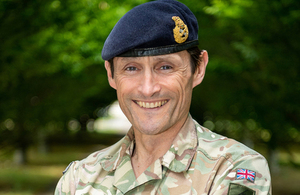Army restructures to confront evolving threats
The Army has outlined its plans to rebalance the Field Army to ensure that it can compete with and defeat adversaries both above and below the threshold of conventional conflict.

Lt Gen Ivan Jones, Commander Field Army (CFA). Crown copyright.
Lt Gen Ivan Jones, Commander Field Army (CFA), has described plans for rebalancing his command which will see changes to the structure of the Field Army’s primary formations.
Lt Gen Ivan Jones, Commander Field Army said:
The character of warfare continues to change as the boundaries between conventional and unconventional warfare become increasingly blurred. The Army must remain adaptable and evolve as a fighting force. The three complementary British Army Divisions harness the wide range of British Army capabilities, providing choice to the Government in defence of the UK’s interests.
Whilst retaining its operational focus, the intention is to rebalance the Army’s formations in order to meet the challenges of constant competition and maintain its high-end warfighting capability.
Lt Gen Jones added:
The Field Army must build on the strong foundation of the 3rd Division’s world class warfighting force. 1st Division provides specialist soldiers and equipment to develop other nations’ armies, deal with disaster and humanitarian crises worldwide and enable our warfighting division. 6th Division focuses on Cyber, Electronic Warfare, Intelligence, Information Operations and unconventional warfare through niche capabilities such as the Specialised Infantry Battalions.
The speed of change is moving at a remarkable rate and it will only get faster and more complex.
This change will be integrated within broader Defence, national and alliance efforts and enable the Field Army to operate and fight more effectively above and below the threshold of conflict. The Field Army rebalancing is part of the Army’s response to the emerging Defence thinking and will create a Field Army of integrated, interdependent and complementary formations from 1 Aug 2019.
-
1st (United Kingdom) Division (1 (UK) Div) with its blend of lighter infantry, logistics, engineers and medics will provide more strategic choice and a range of capabilities, conducting capacity building, stabilisation operations, disaster relief and UK resilience operations. It will include: 4th (Infantry) Brigade, 7th (Infantry) Brigade, 11th (Infantry) Brigade, 51st (Infantry) Brigade, 8th Engineer Brigade, 102nd Logistic Brigade, 104th Logistic Brigade, 2nd Medical Brigade
-
3rd (United Kingdom) Division (3 (UK) Div) will remain as the Army’s primary armoured warfighting force comprising: 1st Armoured Infantry Brigade, 12th Armoured Infantry Brigade, 20th Armoured Infantry Brigade, 1st Artillery Brigade, 101st Logistic Brigade, 25th Engineer Group, 7th Air Defence Group
-
6th (United Kingdom) Division. The re-designation of Force Troops Command (FTC) to 6th (United Kingdom) Division (6 (UK) Div) will provide the Army’s asymmetric edge , orchestrating Intelligence, Counter-Intelligence, Information Operations, Electronic Warfare, Cyber and unconventional warfare. 6 (UK) Div will include: 1st Signal Brigade, 11th Signal Brigade, 1st Intelligence Surveillance and Reconnaissance Brigade, 77th Brigade and the Specialist Infantry Group
There will be no changes to personnel numbers, resourcing, cap badges or locations.
1st August marks the rebirth of a Division which served throughout the First World War and during the Second War. More recently, 6 (UK) Div was formed between 2008-2011 and deployed to Afghanistan as Headquarters Regional Command (South).
Updates to this page
-
First published.